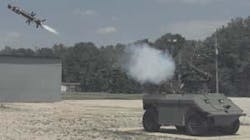By J.R. Wilson
BALTIMORE — Unmanned combat aerial vehicles (UCAVs) and traditional reconnaissance UAVs still may be the "stars" of the unmanned arena, but unmanned underwater vehicles (UUVs) and unmanned ground vehicles (UGVs) are gaining quickly.
Engineers are designing current UGV concept vehicles, for example, for such missions as reconnaissance, surveillance, and target acquisition; explosive ordnance disposal; mine detection and marking; route/area clearing; engineering support and warehouse security and inventory management.
One such effort is the Cooperative Unmanned Ground Attack Robots (COUGAR) program at the Aviation and Mission Research, Development and Engineering Center (AMRDEC) at the Army Aviation and Mission Command at Redstone Arsenal, Ala.
COUGAR, which completed Phase I in May under the name Robotic Applications Multiple Payloads (RAMP), demonstrated a plug-and-play capability in successfully launching a Javelin missile and M-72 Light Antitank Weapon (LAW) rockets against target vehicles.
In Phase II, which runs through 2003, interchangeable missile and ballistic weapons will mount to a robot the size of a Light Armored Vehicle. Those weapons could include an indirect-fire or long-range missile similar to a Hellfire. This new breed of UGV will move in convoy formation to deploy, engage, and destroy several different targets. One soldier can operate the system from a central platform.
Development of COUGAR is proceeding in compliance with the Joint Architecture for Unmanned Ground Systems (JAUGS) effort to maintain interoperability between UGVs and the C4I Tactical Internet as well as intraoperability within families of UGV systems on the digital battlefield. That also is intended to feed back to interoperability with UAVs. C4I stands for command, control, communications, computers, and intelligence.
Robert Wade, AMRDEC's Robotics Team lead engineer, says COUGAR experts also are looking at a marsupial design element, in which a communications UAV would launch from the vehicle after the forward ground robot exceeds the range of its communications link.
U.S. Army and Navy leaders are pursing another ground program called the Basic UXO Gathering System — better known as BUGS — which finds and destroys unexploded ordnance (UXO) such as scatterable submunitions.
BUGS uses as many as 50 small, expendable, man-portable robots operating in tandem. Each BUG will autonomously navigate to a target location, avoid obstacles and other robots along the way, and search for its target. Then the robot will either place a countercharge on the target for later remote detonation and return to the staging area or it will pick up the target and deposit it at a common collection point/disposal area, then move on to the next target.
All of these systems are integral to the evolution of the Future Combat System (FCS), a multi-functional, multi-mission re-configurable system of systems to make the most of joint interoperability, strategic transportability, and commonality of mission roles, including direct and indirect fire, air defense, reconnaissance, troop transport, counter mobility, non-lethal and C2 on the move. FCS is planned for ultimate deployment by 2012.

